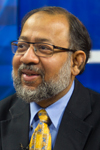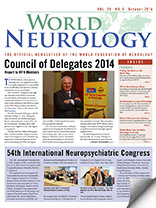Report of a highly successful debut World Brain Day
By Mohammad Wasay, MD, FRCP, FAAN

Mohammad Wasay
The idea of World Brain Day received a lot of appreciation and enthusiasm since its approval by World Federation of Neurology (WFN). Time was short, and the task was huge but the Public Awareness Committee (PAC) and Grisold Wolfgang, secretary-general, WFN, worked over a three-month period to make it a success.
Developing a public message and theme was the foremost task. AAN’s palatucci list serve made it easier. Many slogans, themes and messages were discussed and finally PAC suggested a list of themes, logos, messages and publication material.
All member country delegates were sent a memo by President Raad Shakir regarding information and suggested activities for World Brain Day. World Neurology’s article on World Brain Day also created awareness and momentum for this day.
Publication material including banners, posters and brochures were designed by a professional team of an advertising agency. These materials were made available to all delegate societies by the WFN website. The WFN Facebook page actively posted these materials that were shared by thousands. The number of WFN Facebook page likes were increased by 500 percent over one month. A special post on our Facebook page was a specially recorded video briefing of World Brain Day by Shakir. This video was shared by thousands creating awareness about World Brain Day.
An international media agency was hired to prepare a press briefing and disseminated throughout world media in four languages (English, German, Spanish and French). It was additionally translated into Urdu, Arabic, Hindi and other local languages. July 22, 2014, was a memorable day for WFN in terms of media propagation. Hundreds of newspapers around the world published our press briefing in more than 10 languages. Radio and TV programs were produced and telecast.
Member societies played an exceptional role in the day’s success. Despite limited time, more than 50 member societies organized public awareness activities in their countries. These included press conferences, seminars, patient awareness activities, briefings to media, students and health care workers. The largest numbers of activities were organized in India, Turkey and Pakistan. In India, other professional organizations including epilepsy foundation and Indian Neurorehab society organized activities. A prominent feature of World Brain Day activity in Janakpuri Hospital, New Delhi (organized by M.M. Mehndiratta) was Skype address of Raad Shakir.
The highest impact of this day was created on social media. Many societies shared and posted the World Brain Day banner on their websites. The American Academy of Neurology posted World Brain Day info on its website and Facebook pages with thousands of sharing.
Activities were largely organized by WFN and member societies. Due to a shortage of time, we were not able to actively involve other professional organizations especially Brain Council and Brain Research Organizations, World Health Organization and affiliated organizations like UNICEF.
In my knowledge, none of world days have received so much attention and media coverage as World Brain Day in its debut year. Our goal is to establish it as a joint WFN-WHO day. That requires years of awareness and advocacy. We should start planning for 2015 World Brain Day now with a target to approach millions of people, thousands of doctors (especially neurologists) and hundreds of health care and government officials in 2015.
Wasay is a professor in the Department of Neurology, Aga Khan University, Karachi, Pakistan, and the chair, public awareness and advocacy committee, World Federation of Neurology.
